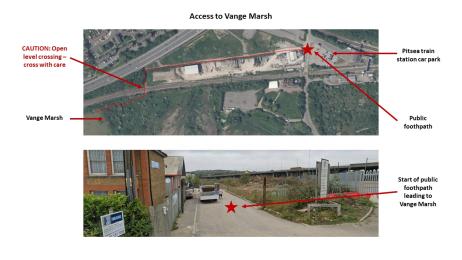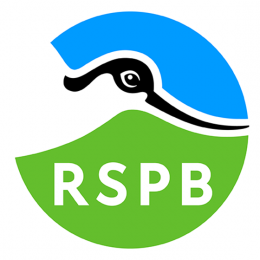Welcome
Vange Marsh is a glorious mosaic of wetland habitats that attract many species of birds throughout the year. The fresh and saltwater lagoons here host breeding Avocet, Little Ringed Plover, Lapwing and Reed Bunting. While Wigeon, Teal and Shoveler are regular visitors in the winter.
Level access
There is level access from the main entrance to:
Viewing pointsGetting here
For further information on accessible travel in Scotland, go to Transport Scotland.Travel by public transport
For more information about train times please visit the C2C website before you travel.
Exit Pitsea railway station and walk straight down the entrance road with the car park to your left. Cross the road at the T junction, continuing straight ahead and take the public footpath. Follow the path to the left, cross the railway line and continue on the path to the right. You will reach a metal kissing gate at the entrance to Vange Marsh.
Follow the public footpath. The start of the footpath is opposite the station road entrance.
CAUTION: Access to the reserve is via a pedestrian level crossing without an automated barrier.
When crossing on foot, read all warning signage prior to crossing and ensure the track is clear in both directions before crossing.
Ensure there is enough time to cross before the next train.
Parking
By Road:
Turn off the A13 at the Pitsea Junction and follow signs for Wat Tyler Country Park. Travel down Pitsea Hall Lane straight over the mini roundabout and then across the bridge. Park your car in the Pitsea railway station's pay and display car park, on the left, just before the level crossing. Exit Pitsea railway station and walk straight down the entrance road with the car park to your left. Cross the road at the T junction, continuing straight ahead and take the public footpath. Follow the path to the left, cross the railway line and continue on the path to the right. You will reach a metal kissing gate at the entrance to Vange Marsh

Arrival
Path to main entrance
Main entrance
Follow the public footpath. The start of the footpath is opposite the station road entrance.
CAUTION: Access to the reserve is via a pedestrian level crossing without an automated barrier.
When crossing on foot, read all warning signage prior to crossing and ensure the track is clear in both directions before crossing.
Ensure there is enough time to cross before the next train.
Metal kissing gate with clear opening of 990 mm (39 inches) at reserve entrance.
All paths are grass, with little change in gradient but uneven in some areas, and variable in width. This reserve can become very wet and muddy and slippery underfoot.

Getting around inside
Getting around outside
Public Footpath
This footpath runs the length of the reserve. All paths are grass, with little change in gradient but uneven in some areas and variable in width. Can become very wet and muddy and slippery underfoot.
Designated Walking Trail
Permissive Footpath
This footpath follows the reserve boundary. It can be combined with public footpath to make 1.5km (1 mile) circular route.
All paths are grass, with little change in gradient but uneven in some areas and variable in width. Can become very wet and muddy and slippery underfoot.
Designated Walking Trail
Sea Wall Footpath
All paths grass, with little change in gradient but uneven in some areas, and variable in width. Can become very wet and muddy and slippery underfoot.
Viewing points
From the main entrance to this area there is level access.
Grass covered with a gradient of approximately 1:5.
Viewing slots at 1.5 m (5 ft), 1.7 m (5 ft 5), and 1.8 m (5 ft 10).
Customer care support
Customer care support
If you have any questions with regard to accessing this reserve, please contact us prior to your visit at southessex@rspb.org.uk and we will be happy to help you.

 Download this guide as docx
Download this guide as docx